| Designation: | Protector |
 |
|---|---|---|
| Manufacturer: | HDT Global | |
| Product type: | Auxiliary Vehicles | |
| Name: | Robot, Unmanned Vehicle |
HDT’s Protector robot has the power, endurance and mobility to clear safe walking trails for dismounted infantry and reduce the amount troops have to carry. The energy efficient robot runs on internal fuel for four days at a time and is a weight and size that if needed, can be lifted over an obstacle. Dimensions of the Protector robot are 76" x 36" x 42" (193 x 90 x 106.7 cm). A simple hand controller (that also functions as a weapon fore-grip) operates the Protector from a distance away from the robot of up to 1,300' (396 m). A mini-flail, mine roller/rake, pre-detonation electronic discharge system, and backhoe/loader are a representative sample of attachments for the Protector robot, and point to the versatility of this compact support device.
The HDT Protector robot shows how one system can fulfill a wide variety of needs:
- Squad – Mission Equipment Transport (S-MET)
- Combat Engineers
- Direct fire support
- Mortar carrier (81mmm and 120mm)
- Anti-armor
- Tethered aerial surveillance & comms relay
- CASEVAC
- Amphibious operations
The HDT Protector robot separates into four modules in a few minutes. Reassembly is equally rapid. Each module is a four-man lift. This modularity simplifies field maintenance.
Also, when an infantry unit is faced with an obstacle that the robot simply cannot cross, even using its folding ramps, the robot can be quickly separated into individual modules, carried across the obstacle, and reassembled.
The heavy loads currently carried by dismounted infantry cause more injuries than hostile action. These loads slow down infantry, robbing them of agility and often ceding the unit’s initiative to the opposing force. Even with these heavy loads, mission endurance is now measured in hours, rather than days.
The purpose of the S-MET robot is not to turn dismounted infantry into a mechanized mounted force, but rather to give leg infantry a simple tool to lighten their load and extend their mission endurance. With an S-MET robot, each squad member only has to carry their fighting load, and their mission endurance is extended to three days.
In order to achieve this goal, the S-MET robot has to carry between 500 and 1,000 pounds (250 and 500 kg) of gear 60 miles (100 km) across terrain that is too difficult for mounted infantry (otherwise, the mission would have been done using vehicles).
To achieve this performance, the robot must be powered by diesel/JP8, which has 100 times the energy density of the best available batteries. Electrical power is simply not practical. In addition, the robot must be tracked, in order to match as closely as possible the rough terrain capability of legged infantry. Finally, the robot has to be narrow and small, so it can fit on goat paths and jungle trails, as well as get through narrow openings in walled compounds.
These key requirements drove our design of the HDT Protector robot: diesel/JP8, tracked, less than one meter wide, and carry 1,000 pounds (500 kg) more than 60 miles (100 km). In addition, the robot generates over 2 kW of electrical power and recharges the BB-2557 and BB-2590 batteries carried by infantry.
HDT Global has also developed a “follow-me” semi-autonomy kit, shown in the photo to the left during testing at Fort Benning. This kit has an optional satellite communications link that provides worldwide remote operations.
In addition, HDT Global has designed a larger ‘heavyweight’ version of the Protector, able to carry 2,000 pounds (1,000 kg) at speeds up to 35 mph (50 kph), with a vehicle width of 54 inches (1.35 m).
Most Combat Engineering missions are not possible dismounted. The weight of the mission-specific equipment, in addition to the standard approach march load, is far too heavy for a person to carry.
Combat Engineers, however, need to be able to operate dismounted. For this reason, the US Army Combat Engineers are developing a Dismounted Engineer Mobility System (DEMS).
Similar to the S-MET, the DEMS must match the cross-country capability of leg infantry, while carrying at least 1,000 pounds (500 kg) of equipment. The DEMS must also generate hydraulic power for tools and attachments, as well as electrical power.
As with the S-MET, these needs are best answered by a small, tracked vehicle, driven by a diesel/JP8 engine and hydrostatic transmission. A hydraulic power take-off must also be included.
The HDT Protector robot’s powertrain is deliberately oversized – it can provide eight gallons (30 liters) per minute of hydraulic flow at 3,000 psi (200 bars), while carrying a full load uphill at 10,000 (3,000 m).
A month of testing at Yuma Proving Grounds showed that the HDT Protector robot’s mini-flail attachment is the most effective device for clearing anti-personnel buried pressure trigger devices, such as land mines and improvised explosive devices (IEDs). The mini-flail was tested on over 2,000 buried devices, in a variety of soil types and at several different depths. The mini-flail performed much better than mine roller/rakes and other counter-IED systems.
- The hammer flail, designed by HDT specifically for the Protector robot, actually excavates a trench, leaving a completely clear walking path for infantry
- For most soil types, the Protector robot’s mini-flail can clear anti-personnel devices at the speed infantry travels in a route march
- In testing, up to half of the devices hit by the mini-flail are disrupted (torn apart), rather than detonated
- The mini-flail can survive the blast from typical anti-personnel land mines without damage
- In the event of a much larger IED blast, the mini-flail has built-in blast shields which allow the mini-flail to sacrificially protect the rest of the robot
- Spare mini-flail attachments can be carried on the robot. A damaged or destroyed mini-flail can be replaced in a few minutes.
The HDT Protector robot can easily push TARDEC’s small mine roller/rake, even though this attachment weighs over 1,600 pounds. TARDEC developed this small roller/rake, based on the SPARK roller. The system has hydraulically deployed rakes, which cut into the soil in order to snag buried command wires.
If a small infantry unit already has an HDT Protector robot for tasks such as route clearance and load carrying, HDT also developed a backhoe/loader kit. Using this backhoe/loader attachment, a single infantry squad can build a platoon-sized combat outpost in just a few days.
- The backhoe/loader attachment disassembles into man-portable components in a few minutes. It takes less than 20 minutes to install the kit onto the Protector robot and get started digging.
- The backhoe/loader kit is also useful to Route Clearance Engineers and Explosive Ordnance Disposal
- The backhoe also has a powerful thumb, which turns the backhoe arm into a very simple, but extremely strong manipulator
- With thousands of pounds of pry force, the backhoe can remotely tear apart a suspected Vehicle Borne Improvised Explosive Device (VBIED), or simply grab the vehicle and drag it to a safe location
The Protector robot can carry 1,250 pounds of supplies over very rough terrain. Shown in the back of the trailer are lightweight folding ramps, which allow the robot to self load/unload onto a truck with a 60" bed height or inside a UH-60 helicopter. Eight Protector robots can fit into a CH-47. Three of the robots can fit into a V-22 Osprey.
Infantry, burdened with their basic fighting load, cannot carry enough supplies for more than a day. This lack of load-carrying capacity means that either mission endurance is very restricted, or frequent aerial resupply is required, which is costly.
- HDT’s Protector robot can add days to mission endurance. The robot can carry a squad’s heavy logistics: water, food, fuel, and ammunition. With over 2 kW of electrical power, it can recharge batteries and act as a generator at night. Using only internal fuel, the robot can travel over 60 miles. An HDT Protector robot can provide over three days of logistics for an infantry squad.
- The Protector robot can carry 750 pounds of cargo on the robot and pull another 500 pounds of gear in a trailer. If the Protector robot is carrying its mini-flail attachment, then its on-vehicle cargo load is 500 pounds, with another 500 pounds in a trailer.
- A single HDT Protector robot can carry a 60 mm mortar, baseplate, bipod, and 100 rounds
- With a trailer, the HDT Protector robot can carry an 81 mm mortar, baseplate, bipod, and 100 rounds
- Two HDT Protector robots with trailers can carry a 120 mm mortar, baseplate, bipod, and 100 rounds
- For direct fire, an M-2 or Mk19 can be pintle mounted on the Protector robot’s rear deck, along with a gun shield and dozens of boxes of ammunition
- The Protector robot is equipped with stretcher mounting points on each side, allowing the robot to carry two wounded personnel. In more open terrain, the stretchers can be used as panniers to carry less dense cargo
The firepower of a dismounted infantry unit is limited by the weight of the weapon and the amount of ammunition that they can carry. With a HDT Protector robot, a dismounted squad has much greater lethality, and they can deliver it remotely.
The Protector robot can carry the standard M-153 Common Remote Operated Weapon Station (CROWS), which can fire a M240B, M2, or Mk19, while on the move. The CROWS can also be equipped with a Javelin missile, in addition to the primary weapon.
The US military has over ten thousand M-153 CROWS in inventory, any of which can be mounted on a HDT Protector robot.
A live fire demonstration of the robot and CROWS with an M240B was conducted at Fort Benning.
While there are advantages to being able to remotely operate a mobile direct fire weapon system, many infantry soldiers and marines have requested the simpler and lighter-weight option of manually operating a weapon that is pedestal-mounted on the back of the robot.
The images below show the robot with the frontal armor portion of its armor kit. The pedestal mount also has an armored gun shield.
Forcible entry expeditionary operations have a greater risk of dismounted infantry encountering opposing armored vehicles, at a time when support from other ground or air assets may be more difficult to achieve. While Javelin missiles can provide some organic protection, the missile’s weight limits how many Javelins a dismounted unit can carry.
Javelin missiles have also proved useful against hardened targets, such as bunkers and walled compounds.
The HDT Protector robot can carry five Javelin missiles and its Command Launch Unit, or three TOW missiles and its launcher. The robot can also carry a seven-pack of 70mm rockets with laser-guided precision seeker heads and a laser designator/range-finder. All of these missiles still must be manually launched.
Organic indirect fire can be as important to a dismounted infantry unit as direct fire, sometimes more so. At most, however, small infantry units carry a 60mm mortar and each member of the unit carries one round. A single HDT Protector robot can carry a 60mm mortar, bipod, the full M7 baseplate, and 100 rounds.
A Protector robot with its logistics trailer can carry an 81mm mortar, bipod, baseplate, and 100 rounds. Two MUV robots with trailers can carry a 120mm mortar, bipod, baseplate, precision aiming electronics, and 100 rounds.
The design shown above has a rotary hydraulic actuation system that can deploy a 120mm mortar in seconds, using hydraulic force and the weight of the robot to set the baseplate firmly into the ground. The crew can fire several rounds, retrieve the mortar, and be on the move in less than two minutes.
Dismounted infantry units have come to greatly value having an Unmanned Aerial Vehicle (UAV) overhead, but small UAV’s have limited endurance. Larger UAV’s have limited availability.
A new class of tethered UAV’s are available that can stay 1,000 feet (305 m) above the ground for weeks, with power and video going through their tether. The HDT Protector robot can deploy a tethered UAV with EO/IR sensors for ISR or a radio relay to provide wide area coverage.
When a small, dismounted infantry unit takes casualties and has to exfiltrate under fire to a safe landing zone, each unit member who has to help carry a litter reduces the unit’s ability to provide defensive fire. One or two non-ambulatory casualties per squad can immobilize the unit.
Hard points are built into each side of the Protector robot for stretcher bars.
Talon folding stretchers and the stretcher bars can be compactly carried while the robot is performing a variety of other missions. If needed, the robot can be set-up for CASEVAC in less than a minute, allowing for rapid exfiltration to a safe landing zone.
MEDEVAC helicopters can carry an HDT Protector robot internally.
HDT Global has designed an amphibious kit for the Protector robot. The pontoon attaches to the same hard points used for the stretcher bars. The propulsion module attaches to the rear bumper payload attachment fittings.
The propulsion module has a pod-mounted propeller.
The pod can rotate 360° in the yaw axis, to provide both propulsion and steering. The pod assembly can also rotate back and up in the pitch axis, to retract the propeller once the robot reaches land. The propeller is powered by a small hydraulic rotary motor in the pod, which is driven by hydraulic flow from the power take-off.
Using our optional satellite communications kit, the robot is capable of being launched from over the horizon and swimming to shore. Until the amphibious kit is built and tested, it is not possible to know its actual performance in terms of speed and sea state.
|
||||||||||||||||||||||||
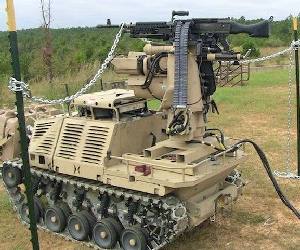 |
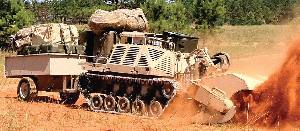 |
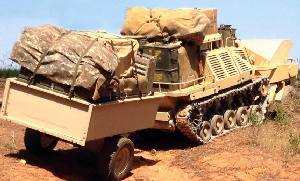 |
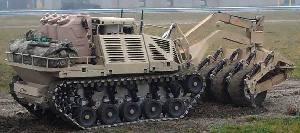 |
 |
 |
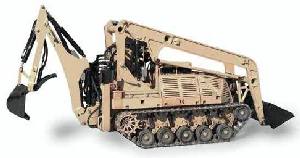 |
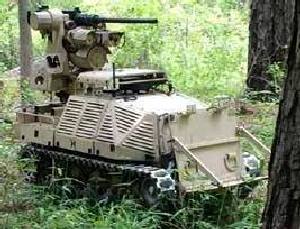 |
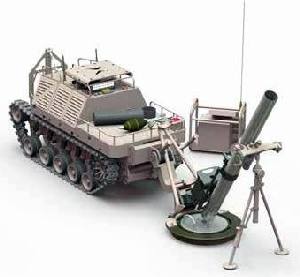 |
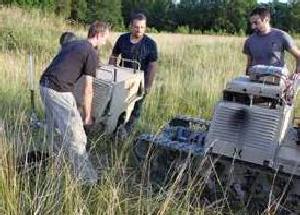 |
